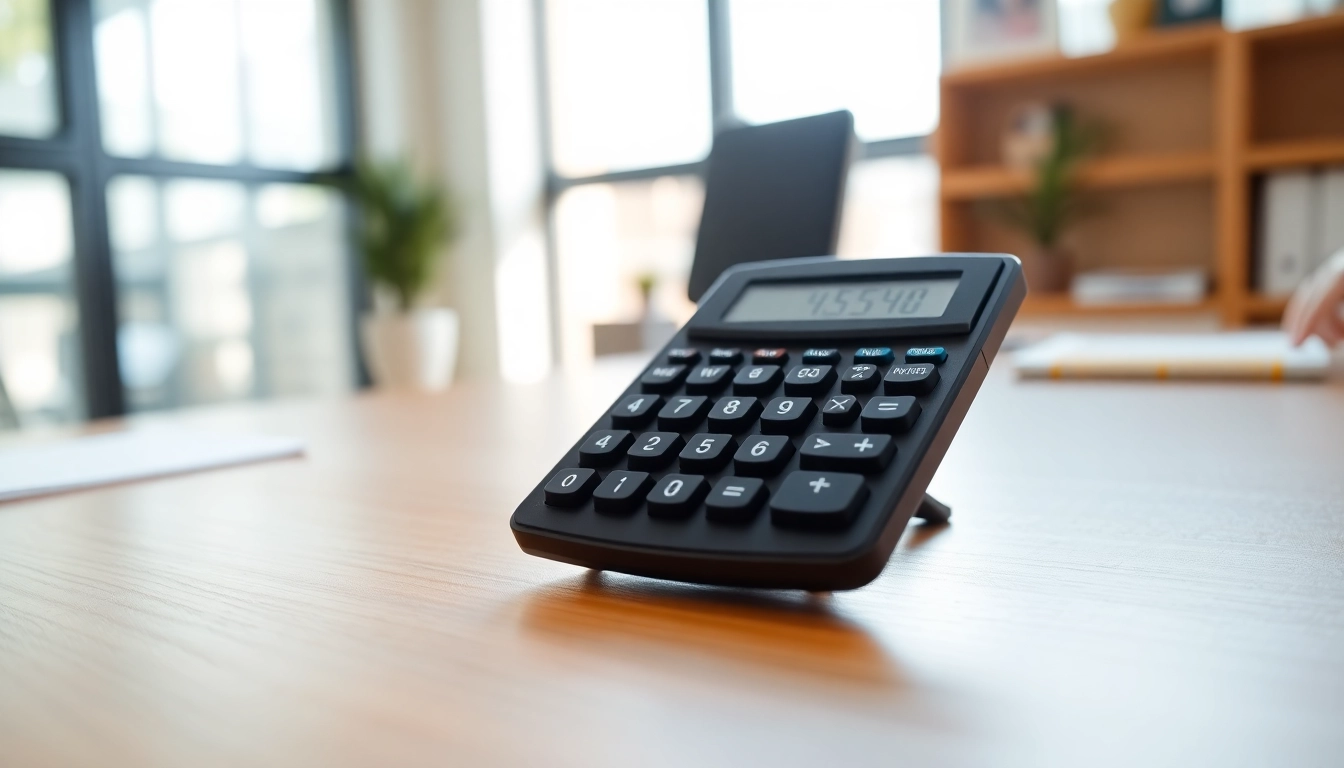Understanding the Basic Calculator
What is a Basic Calculator?
A Basic Calculator is a simple yet efficient device or tool used to perform basic mathematical operations such as addition, subtraction, multiplication, and division. These calculators can be found in various forms, including handheld devices, applications on smartphones, and online interfaces. The functionality of a Basic Calculator typically centers on arithmetic calculations, providing users with a straightforward way to handle everyday math tasks, often with clear displays and intuitive controls. Users can access a Basic Calculator online, such as through this Basic Calculator, which conveniently allows for immediate calculations without requiring any installation or download.
Key Functions and Features of Basic Calculator
The core functions of a Basic Calculator are designed to cover the fundamental needs of most mathematical calculations. Typical features include:
- Addition (+): Combines numbers to find the total sum.
- Subtraction (−): Determines the difference between numbers.
- Multiplication (×): Calculates the product of numbers.
- Division (÷): Divides one number by another to find the quotient.
- Memory Functions: Some models include a memory function that allows users to store and recall previous numbers.
- Clear/Cancel Button: Resets calculations or clears the current entry for new input.
- Square Root (√): Computes the square root of a number, which is a useful function in many mathematical scenarios.
Each of these functions plays a fundamental role in providing quick and accurate calculations, making everyday math manageable for users of all ages and backgrounds.
Benefits of Using a Basic Calculator
The use of a Basic Calculator brings numerous advantages that can enhance productivity and accuracy in various contexts:
- Ease of Use: Basic Calculators are designed to be user-friendly, making them accessible to individuals with varying degrees of mathematical proficiency.
- Speed: Calculators allow users to perform calculations much faster than doing them manually, which is particularly beneficial for time-sensitive tasks.
- Accuracy: Digital calculations reduce the likelihood of human error, providing more reliable results, especially in critical situations such as finance or engineering.
- Portability: Many Basic Calculators are compact and lightweight, making them easy to carry and use anywhere, from classrooms to workplaces.
- Cost-Effectiveness: Basic Calculators are generally inexpensive, making them a viable option for students, professionals, and households alike.
How to Use a Basic Calculator
Step-by-Step Guide to Performing Basic Operations
Using a Basic Calculator is a straightforward process. Here’s a simple guide to performing basic operations:
- Turn On the Calculator: Press the power button to activate the device.
- Enter the First Number: Use the numeric keypad to input the first number of your calculation.
- Select the Operation: Press the corresponding button for the operation you want to perform (addition, subtraction, multiplication, or division).
- Enter the Second Number: Input the second number for the calculation.
- Calculate: Press the equals button (=) to obtain the result.
- Review the Result: Check the display to view the outcome of your calculation.
By following these simple steps, users can easily perform basic calculations with accuracy and confidence, whether calculating their shopping expenses or managing finances.
Common Errors and How to Avoid Them
While using a Basic Calculator is often straightforward, users may encounter some common errors. Here are some pitfalls to look out for and ways to avoid them:
- Mis-Pressing Keys: Double-check the keys you press while entering numbers and operators. It’s easy to accidentally hit the wrong button, altering your intended calculation.
- Forgetting the Operation: Ensure that all necessary operations are included. For example, many users forget to press the equals button, leading to confusion.
- Incorrect Order of Operations: In subsequent calculations, be aware of the order in which operations should be performed. For instance, multiplication should take precedence over addition.
By being mindful of these common mistakes, users can enhance their efficiency and accuracy when using a Basic Calculator.
Tips for Efficient Calculation with Basic Calculator
To maximize the efficiency of your Basic Calculator, consider implementing the following tips:
- Practice Regularly: Familiarizing yourself with the calculator’s layout and functions can improve your speed and efficiency over time.
- Utilize Memory Functions: If your calculator has a memory function, use it to store intermediate results, which can simplify complex calculations.
- Organize Your Workspace: Ensure that your calculator is easily accessible and that there’s sufficient space for you to work comfortably without distractions.
Advanced Functions and Uses
Beyond Basic Arithmetic: Exploring Advanced Functions
While the primary role of a Basic Calculator is to perform straightforward arithmetic, some models may offer additional features that can aid in more complex mathematical tasks. These might include:
- Square Roots: As mentioned earlier, calculating square roots can be vital when dealing with geometric problems.
- Percentage Calculations: Many Basic Calculators allow users to easily convert numbers into percentages, which is useful in financial contexts.
- Memory Recall: The ability to store and recall past entries can help when performing multi-step calculations.
Understanding these additional functions can empower users to get more out of their Basic Calculator, making it a versatile tool beyond simple arithmetic.
Using a Basic Calculator for Everyday Calculations
Basic Calculators have numerous everyday applications that can simplify daily tasks. Here are some examples:
- Budgeting: Individuals can use calculators to track income and expenses, ensuring they stay on top of their financial commitments.
- Cooking: Converting measurements in recipes often requires arithmetic, making calculators indispensable for cooking enthusiasts.
- Shopping: Calculators help shoppers quickly calculate totals, discounts, and taxes, improving the buying experience.
By employing a Basic Calculator for these common tasks, users can streamline their routines and reduce the cognitive load associated with manual calculations.
Practical Scenarios for Basic Calculator Usage
There are various practical scenarios where a Basic Calculator proves beneficial. Here are a few that illustrate its versatility:
- Accounting: Professionals in this field utilize calculators daily to reconcile accounts, compute totals, and forecast financial outcomes.
- Education: Students frequently depend on Basic Calculators to assist with homework, tests, and projects, particularly in mathematics and science subjects.
- Construction: Builders and contractors apply calculators to estimate costs based on material quantities and labor rates, ensuring more accurate financial projections.
Choosing the Right Basic Calculator
Features to Look for When Selecting a Basic Calculator
Choosing the right Basic Calculator involves considering specific features that align with your needs. Here are some important aspects to consider:
- Size and Portability: Depending on where you’ll use the calculator most, a compact design might be necessary for portability.
- Display: Look for a clear and legible display that can accommodate larger numbers and mathematical expressions.
- Durability: A sturdy design is essential if you’ll be using your calculator frequently or transporting it often.
Understanding your unique requirements will guide you in selecting a Basic Calculator that meets your everyday needs.
Comparing Different Models of Basic Calculator
When shopping for a Basic Calculator, you’ll encounter a range of models. Here are some factors to consider when comparing various options:
- Functionality: Make a list of the functions you require and compare them against models to ensure that the calculator fits your needs.
- Brand Reputation: Researching user reviews can provide insights into the reliability of different models and manufacturers.
- Price: Calculators range in price, so consider your budget alongside the features offered. Sometimes, more expensive models may have features you don’t need.
Reviews and Recommendations
While personal recommendations can be invaluable when selecting a Basic Calculator, user reviews and product comparisons can also guide your decision-making process. Seeking feedback from peers or checking dedicated review sites can help determine which models are user favorites based on their functionality, durability, and overall effectiveness. Additionally, consider availability, warranties, and customer service as integral parts of the decision-making process.
Troubleshooting and Maintenance
Common Problems with Basic Calculator
Even straightforward devices like Basic Calculators can encounter issues. Here are some typical problems you may experience:
- Display Issues: If the display is dim or non-responsive, this could indicate low battery power or a need for recalibration.
- Incorrect Calculations: This may result from button malfunctions or misunderstanding of how to input operations accurately.
Identifying the root of these common problems is crucial for resolving them swiftly and efficiently.
Maintaining Your Basic Calculator for Longevity
To ensure your Basic Calculator lasts, consider implementing the following maintenance tips:
- Store in a Safe Place: Keep your calculator protected from extreme temperatures and moisture to prevent internal damage.
- Regular Battery Checks: Ensure your calculator has fresh batteries or is charged, preventing interruptions during use.
By following these simple maintenance practices, you can extend the effective lifespan of your Basic Calculator significantly.
When to Replace Your Basic Calculator
It’s vital to know when to retire your Basic Calculator and invest in a new one. Signs that it’s time for a replacement include:
- Frequent Malfunctions: If the device consistently displays errors despite regular maintenance, it may be time for a new purchase.
- Inability to Perform Required Functions: If your needs have outgrown the capabilities of your current model, consider replacing it with one that meets your requirements.
Understanding when to replace your Basic Calculator ensures that you have an effective tool at your disposal for all your arithmetic needs.















Leave a Reply